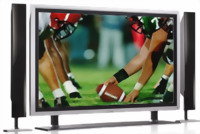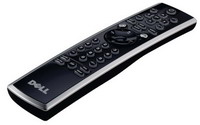
|
|
 |

|


George Graves, March 2, 2006 HDTV Solutions Dell is a well-known player in the PC computer field, selling strictly mail-order to millions of customers a year. They are fairly new to the consumer electronics segment, and are now selling a trio of flat-screen, plasma TVs consisting of a 37", a brand new 42", and a 50". This review focuses on the new Dell 42" W4201C plasma. Although the W4201C manual hardly mentions it, this set is HDTV capable as opposed to being HDTV ready. Weighing in at 97.5 pounds (44.2 kg) and measuring 40.7 x 28.05 x 9.75 inches (1033.7 x 712.5x 247.8 mm), the W4201C may be stand or wall mounted. Speakers are optional. There are no controls on the front to mar the "picture-frame" look of the set with its contemporary brushed champagne-colored frame. Instead, all of the on-unit controls are located on the bottom right-hand edge of the display so that one has to reach under the frame to push up on them. Since the control "legend" on the front of the frame is small and very light in color, it's quite difficult to see. The back panel holds all of the I/O (Input/Output) connectors and because of the option to wall mount the unit, all jacks are mounted vertically under the back panel. Awkward perhaps, but necessary to assure that the panel will hang flush to the wall with no cords interfering.
I/O Connections
One of the seven pairs of RCA jacks is provided for the HDMI inputs in case your digital input is DVI rather than HDMI. DVI doesn't carry audio, so these are a thoughtful touch, but you will need to add your own HDMI cable and/or DVI adapter.
On the right-hand side of the HDTV, accessible from the front, is the ubiquitous "convenience" video input group consisting of a composite input, an S-VHS input and a right and left audio input but no component or HDMI interface. Outputs are less comprehensive. There is a single composite video out and a companion pair of RCA audio outputs enabling a VCR to record video from the built-in NTSC tuner. In addition to a single RCA output for a self-powered subwoofer, there is also a TOSLINK optical digital output (SPDIF) to feed an AV receiver or digital surround decoder. Rounding out the jack-field is a pair of left and right five-way binding posts for connecting a pair of optional matching Dell speakers or others of your choosing.
While setting up the Dell W4201C for this review, I discovered that the remote control appeared dead for reasons unrelated to batteries. It was capable of generating a signal, but unfortunately the W4201C Plasma HDTV could not detect it. It is unknown whether it was programmed incorrectly or whether the remote sensor or the RC circuitry in the TV was defective. I proceeded to calibrate the HDTV screen for black level, white level, color saturation, hue, and gray scale purity, color bias, and linearity utilizing the "Video Essentials" set-up DVD. Like most modern TVs, all set-up controls are menu driven. I found some of the menus poorly laid-out and often confusing, especially those concerned with aspect ratio, but one would soon get used to them. Calibration Results Performance Plasma screens have several advantages that make them look simply great. One is contrast ratio. Most technologies such as LCD and CRT have contrast ratios in the hundreds. Plasma screens can have contrast ratios in the thousands and the Dell 4201C is no exception with a contrast ratio of 10,000:1! This contrast ratio is cutting edge and no purveyor of plasma TVs that I know can match it as of this date. Also, due to the color phosphors (as well as the contrast between the colors) used in this display, it exhibits some of the most eye-popping color accuracy and quality this reviewer has ever encountered. The colors are simply breathtaking. Reds are rendered as true reds, not orange/red and they don't bleed, shimmy or over-saturate (bloom) and the green of foliage is the most natural I've ever encountered. This color fidelity is simply amazing. I was watching an HD program on the 4201C, which featured a classic automobile that I know very well, as it belongs to an acquaintance of mine. It's been used in a number of automotive documentaries and its color has never looked right in any of them. I've seen this particular program before on my rear-projection Pioneer Elite (rear screen) HDTV, and the color wasn't correct. On the 4201C it was perfect and spot-on. Impressive. The interesting thing is that even though I realize that the resolution on this TV is nowhere near HDTV standards, while watching the 4201C, I simply did not notice it. The picture looks so good and is so artifact-free, that I found myself totally involved with the program and ignoring the technical aspects of the picture altogether. The lack of color fringing and dot-crawl coupled with the perfect convergence afforded by flat-screen technologies makes viewing a real joy. Black-and white presentations are likewise impressive. Good prints of old black and white movies on DVD show excellent gray scale graduation (thanks again to that incredible 10,000:1 contrast ratio) without any trace of color bias anywhere on the screen (with the color temperature set at daylight). Grays are grays, not sepia, not blue, not green. Conclusion |
Bookmark:
![]() del.icio.us
del.icio.us
![]() Reddit
Reddit
![]() Google
Google
| Send this Page | Print this Page | Report Errors |









